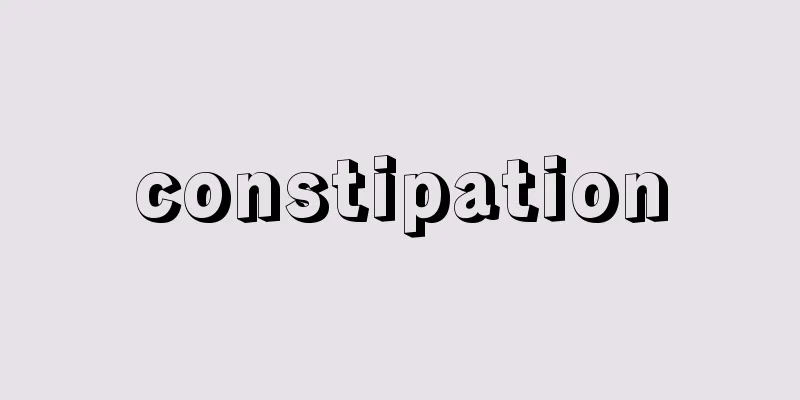constipation

|
Concept Constipation is characterized by infrequent bowel movements and difficulty in passing stool (generally less than twice a week, or no bowel movements for more than three days), and is often accompanied by increased stool hardness. However, bowel habits vary greatly from person to person, and while there are some cases where bowel movements are less than the above-mentioned standard and there are also cases where people have bowel movements almost every day but complain of hard stools or difficulty in passing stool. Clinically, constipation becomes a problem when it is accompanied by symptoms such as difficulty in passing stool and abdominal distension. However, tenesmus, such as that associated with proctitis, is not considered constipation. Chronic constipation is seen in 10-20% of people, and it is thought that the reason it is more common in women is due to the effects of progesterone. Pathophysiology: Food transit time is roughly 2 hours in the stomach, 4 hours in the small intestine, and about 1 day in the large intestine. Prolonged transit time through the stomach or small intestine rarely causes constipation. This is because the stomach and small intestine do not absorb much water from their contents, so even if transit time is prolonged, it is unlikely to be a noticeable symptom of "constipation." On the other hand, prolonged transit time through the large intestine can cause constipation. The pathological classification of constipation is shown in Table 2-11-1. The most common type is functional constipation, which was defined by Rome III as shown in Table 2-11-2. Traditionally, functional constipation was often further divided into atonic constipation, spastic constipation, and rectal constipation, but recently it has become more common to classify it into slow transit type, normal transit type, and outlet disorder (Table 2-11-3). In Japan, delayed colonic transit time was the most common type, but recently normal colonic transit time has become more common. Delayed colonic transit time occurs when the time it takes for feces to pass through the large intestine is extended due to reduced peristalsis and tone (tonus) of the large intestine. High water absorption in the large intestine results in hard stool. It is often seen in elderly people, thin women, and people who have been bedridden for a long time. Normal colonic transit time occurs when the tone of the left colon is persistently too strong, blocking the flow of the contents of the large intestine, and defecation is often accompanied by abdominal pain. Hard stool is passed at first (rabbit droppings-like), and tends to become soft in the latter half. Even after defecation, the patient does not feel relieved immediately, and a small amount of loose stool continues to be passed. This type overlaps with constipation-type irritable bowel syndrome and is often accompanied by diverticula. Evacuation disorder is a condition in which stool that has entered the rectum cannot be properly expelled. Organ prolapse such as rectal prolapse and rectal prolapse leads to rectal constipation. Rectal constipation can also occur when the defecation reflex caused by the stretching of the rectal wall becomes ineffective as a result of the continued habit of holding in the urge to defecate. On the other hand, organic causes include those accompanied by obstruction of passage of the large intestine (cancer, inflammation, giant intraperitoneal tumors, sigmoid colon volvulus, postoperative anastomotic stenosis, etc.) and abnormalities of the nerves in the intestinal wall (Hirschsprung's disease, secondary megacolon). Systemic conditions that make one more susceptible to constipation include aging, general debility, neurological diseases (Parkinson's disease, stroke, spinal cord disease, psychiatric illness, etc.), diabetes, hypothyroidism, pregnancy, electrolyte abnormalities, dehydration, liver cirrhosis, and carcinomatous peritonitis. Other factors that can cause constipation besides illness include lack of exercise, irregular eating habits, inadequate diet, inadequate fiber intake, and heating and wearing too many thick clothes. Constipation caused by medication is also common (antidiarrheals, narcotics, anticholinergics, anticancer drugs, diuretics, analgesics, antacids, anti-Parkinson's drugs, psychotropic drugs, ion exchange resins, barium, etc.). Of these, those not caused by colonic lesions often show symptoms of delayed colonic transit time, but ion exchange resins and barium cause constipation because the drugs themselves harden the stool. DiagnosisWhen diagnosing constipation, it is important to determine whether emergency treatment is required and not to overlook the underlying disease (especially cancer, etc.) that is causing the constipation (Figure 2-11-1). If constipation worsens, it can even cause ileus. Furthermore, when a person who has not previously had constipation develops a tendency to become constipated without any trigger, it is necessary to search for the above diseases even if the symptoms are mild. It should be noted that the above diagnostic criteria for functional constipation do not rule out organic constipation. 1) Urgency assessment: If symptoms are severe and include abdominal pain, increased bowel sounds, vomiting, or small intestinal gas, there is a risk of ileus and emergency treatment is required [⇨8-5-15)]. 2) Assessment of the presence or absence of underlying disease: Next, evaluate the possibility of the existence of an underlying disease. If it has not changed for many years, it can be assumed that it is functional, but recent onset of constipation should raise suspicion of the existence of an underlying disease. Depending on the situation, tests for colon diseases and other systemic diseases should be conducted. It is a good idea to check the stool for occult blood at least once to avoid overlooking conditions such as colon cancer. If there are signs suggesting a passage disorder, a colon examination is essential, but attention should be paid to ileus symptoms caused by pretreatment medications. With the increase in the elderly population in recent years, constipation caused by medications has also been on the rise, and attention should also be paid to the possibility of excessive use of laxatives (laxative colon syndrome). 3) Type of constipation: If it is not thought to be due to organic disease or medication, the type of constipation is evaluated. Here too, the most important step is to ask about the time of onset, frequency of bowel movements, presence or absence of straining or pain during defecation, presence or absence of a feeling of incomplete evacuation, and the shape of the stool. Many patients complain of being unable to pass large, firm stools, but if there is any uncertainty, it is a good idea to first ask the patient to write down on paper the size and shape of their typical stool and what they consider to be normal stool. It is not uncommon for the patient to think that there is something abnormal even when there is no problem. Functional constipation also has an aspect of a lifestyle-related disease, so it is important to help identify lifestyle habits that are contributing to constipation (inadequate diet, excessive use of fast food, heating and excessive clothing, lack of exercise, irregular lifestyle, mental stress, habit of holding in bowel movements, etc.). Physical examination includes abdominal surgical scars, abdominal distension, level of bowel sounds, and the presence or absence of anal lesions. Digital rectal examination is used to evaluate the presence or absence of fecal masses, anal stenosis, anal pain, rectal masses, and anal sphincter tonus. Autonomic nervous system abnormalities are also evaluated. 4) Treatment and measures for constipation: If an underlying disease is identified, it is treated first. As functional constipation, which is the most common, often has aspects of lifestyle-related diseases, it is important to first advise the patient to improve their lifestyle (high fiber diet, drinking water early in the morning, and having a regular lifestyle, especially breakfast). When prescribing medication, bulk laxatives, saline laxatives, and sugar laxatives are recommended first, and pantethine is often effective for delayed intestinal transit time constipation, which is common in Japan. If these are not effective enough, stimulant laxatives should be considered. In decompensated cirrhosis, constipation can induce hepatic encephalopathy, so prevention is necessary. Lactulose is also useful for preventing and treating encephalopathy, so it is often used in such cases. Lactulose, which has a laxative effect due to lactic acid fermentation, is physiological and suitable for young children. In cases of severe constipation, external medications such as enemas are also used. In cases of normal colonic transit time constipation, drugs for treating irritable colon are often effective. [Matsuhashi Nobuyuki] Classification of constipation Table 2-11-1 Diagnostic criteria for functional constipation* (Rome III) Table 2-11-2 Type of functional constipation Table 2-11-3 Dealing with constipation cases "> Figure 2-11-1 Source : Internal Medicine, 10th Edition About Internal Medicine, 10th Edition Information |
|
概念 便秘は排便回数が少なくて便が出てきにくいこと(おおむね週に2回以下程度,あるいは3日以上排便がない)であり,便の硬さの増大を伴うことが多い.ただ,排便習慣は個人差が大きく,上記基準以下の排便回数でもなんら問題のない例もあれば逆に毎日のように排便があっても便の硬結や排便困難感を訴える場合もある.臨床的に便秘として問題になるのは排便困難,腹部膨満などの症状を伴う場合である.ただ,直腸炎のときのしぶりなどは便秘とはしない.慢性便秘は10~20%にみられ,女性に多いのはプロゲステロンの作用と考えられている. 病態生理 食物の通過時間は,おおざっぱに胃が2時間,小腸が4時間,大腸が1日前後である.胃や小腸の通過時間が延びて便秘が問題となることはほとんどない.なぜなら,胃や小腸では内容物からの水分の吸収は少ないため,通過時間が延びても“便秘”としての自覚症状にはなりにくいためである.一方,大腸の通過時間が延びると便秘をきたしうる.便秘の病態分類を表2-11-1に示した.最も多いのは機能性便秘であり,RomeⅢにより表2-11-2のように定義された.機能性便秘は従来さらに弛緩性便秘,痙攣性便秘,直腸性便秘に分けることが多かったが最近は結腸通過時間遅延型(slow transit type),結腸通過時間正常型(normal transit type),排出障害型(outlet disorder)として分類することが多くなってきた(表2-11-3).日本では従来結腸通過時間遅延型が多かったが,最近は結腸通過時間正常型が多くなってきている.結腸通過時間遅延型は大腸の蠕動,緊張(トーヌス)が低下していることにより大腸内の糞便通過時間が延長して起こるものである.大腸で水分が高度に吸収される結果便が硬くなる.高齢者ややせ型の女性,長期臥床者などでよくみられる.結腸通過時間正常型は逆に左側結腸の緊張が持続的に強すぎてブロックされて大腸内容の推進が十分起こらないために起こるもので,排便に際しては腹痛を伴うことが多い.最初硬い便が出て(兎糞状),後半は軟便になりがちである.いったん排便してもすぐすっきりせずしばらく残便感,少量のゆるい便の排便が続く.便秘型の過敏性腸症候群と重なり,よく大腸憩室を伴う.排出障害型は直腸内に入ってきた便をうまく排出できない状態である.直腸脱,直腸瘤などの臓器脱で直腸型便秘となる.また,便意を我慢する習慣を続けた結果直腸壁の伸展刺激による排便反射がうまく起こらなくなった結果でも直腸型便秘となる. 一方,器質的な原因があるものとしては,大腸の通過障害を伴うもの(癌,炎症,腹腔内巨大腫瘍,S状結腸軸捻転,術後吻合部狭窄など),腸壁の神経の異常(Hirschsprung病,続発性巨大結腸症)などがある.便秘を起こしやすい全身状況としては加齢,全身衰弱,神経疾患(Parkinson病,脳卒中,脊髄疾患,精神病など),糖尿病,甲状腺機能低下症,妊娠,電解質異常,脱水,肝硬変,癌性腹膜炎などがある.病気以外でも運動不足,食事の不規則,摂食不十分,繊維摂取不足,暖房・厚着のしすぎなども便秘の要因になる.また,薬剤による便秘もよくみられる(止痢薬,麻薬,抗コリン薬,抗癌薬,利尿薬,鎮痛薬,制酸薬,抗Parkinson薬,向精神薬,イオン交換樹脂,バリウムなど).これらのうち,大腸病変によるもの以外では結腸通過時間遅延型の病像をとることが多いが,イオン交換樹脂やバリウムでは薬剤自体が便を固まらせるために便秘となる. 診断 便秘の診断で重要なのは,緊急に処置を要するかの判断と,便秘の原因となっている基礎疾患(特に癌など)を見落とさないことである(図2-11-1).便秘が亢じるとイレウスも引き起こすことがある.また,従来便秘のなかった人に誘因なく発生した便秘傾向については,症状が軽くても上記諸疾患を念頭においた検索が必要となる.上記機能性便秘の診断基準では器質的便秘などは除外できないことに注意. 1)緊急性の有無の評価: 症状が強く腹痛,腸音亢進,嘔吐,小腸ガスなどを伴うならイレウスの恐れもあり,緊急に対処する【⇨8-5-15)】. 2)原因疾患の有無の評価: ついで原因疾患の存在の可能性を評価する.長年変わらなければまず機能性と考えて問題ないが,最近発症した便秘は原因疾患の存在を疑わせる.状況に応じて大腸疾患やほかの全身疾患の検査する.大腸癌などを見落とさないため,1回は便潜血をチェックしておくのがよい.通過障害を疑わせる兆候があれば大腸検査は必須だが,前処置薬によるイレウス症状に注意が必要.近年は高齢者が増加してきて薬剤による便秘も増えており,また下剤の過剰使用(下剤性結腸症候群)の可能性にも留意が必要である. 3)便秘のタイプの評価: 器質的疾患や薬剤によるものでないと考えられた場合は,便秘のタイプを評価する.これも問診が最も重要である.発症時期とともに排便頻度,排便時の怒責・痛みの有無,残便感の有無,便の形状を問診する.大きいしっかりした便が出ない,という訴えは多いが,まずは本当に便秘というほどの問題があるのかどうか,多少とも不確実な場合は患者に典型的な自分の便と自分が正常と思う便の大きさ・形状を紙に書いてもらうとよい.問題がなくても本人は異常と思っていることはまれではない.機能性便秘は生活習慣病の側面もあり,便秘の要因になっている生活習慣(摂食不十分,ファストフード偏重,暖房・厚着のしすぎ,運動不足,不規則な生活,精神的緊張,排便を我慢する習慣,など)を明らかにする手助けをするのも重要である.身体所見では腹部手術瘢痕,腹部膨満,腸雑音の程度,肛門病変の有無をみる.直腸指診で便塊や肛門狭窄,肛門痛の有無,直腸腫瘤の有無,肛門括約筋のトーヌスなどを評価する.自律神経異常も評価する. 4)便秘の治療法・対策: 背景疾患が判明した場合は,まずはその治療を行う.最も多い機能性便秘は生活習慣病の側面があることが多いので,まず生活改善(高繊維食,早朝の飲水,規則正しい生活,特に朝食)を指導するのが重要である.投薬する場合は,まずは膨張性下剤,塩類下剤,糖類下剤,などがよく,日本で多い腸通過時間遅延型便秘ではパンテチンがしばしば有効.これらで十分な効果がないとき,刺激性下剤を考慮する.非代償期の肝硬変では,便秘は肝性脳症の誘引になるため予防の必要がある.ラクツロースは脳症の予防・治療にも有用なので,そのような症例によく使われる.乳酸発酵による緩下作用のラクツロースは生理的で,幼少児にも適している.高度の便秘の場合には浣腸などの外用薬も使われる.結腸通過時間正常型便秘では過敏性大腸治療薬がしばしば奏効する.[松橋信行] 便秘の分類"> 表2-11-1 機能性便秘*の診断基準(RomeⅢ)"> 表2-11-2 機能性便秘の型"> 表2-11-3 便秘症例への対処"> 図2-11-1 出典 内科学 第10版内科学 第10版について 情報 |
Recommend
Oriya - Oriyago
...There is a considerable movement of population...
Ruling - Ruling
This is a mountain hakama (Japanese traditional lo...
Lambuth, Walter Russell
Year of death: September 26, 1921 Born: November 1...
The boar of Mount Erymanthus
...After a whole year of hunting, he captured the...
Lydia Koidula
1843‐86 Estonian poet. Showing talent for poetry a...
Divorce - Rien
Generally, the separation of a husband and wife i...
Tengger Mountains - Tenggersanchi (English spelling) Tengger
A mountainous region in the eastern part of Java,...
Cyclopropane - cyclopropane (English spelling)
A cycloalkane. Also called trimethylene. A colorl...
School bug (gnathostome) - School bug
It is a nematode of the family Dictyostelium that ...
Electric contact
This refers to the part in relays and temperature ...
Piave, FM (English name) PiaveFM
...It also incorporates a kind of social criticis...
Inertial mass
An object's mass can be divided into inertial ...
Munafuda - Munafuda
These are records of the construction or repair o...
Black marlin
…It is also called Shirokawa. Its English name is...
Baijiu (English name) (China)
A Chinese alcoholic beverage, a general term for ...









